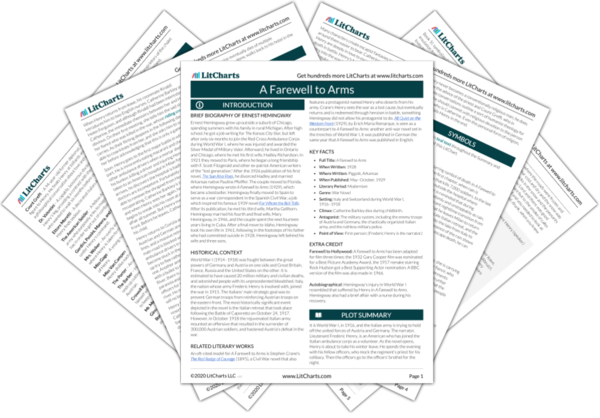War
A Farewell to Arms takes place in Italy during World War I, and the lives of all the characters are marked by the war. Most of the characters, from Henry and Catherine down to the soldiers and shop owners whom Henry meets, are humanists who echo Hemingway's view that war is a senseless waste of life. The few characters that support the war are presented as zealots to be either feared, as in the case…
read analysis of WarLove and Loss
Much is made throughout the novel of Henry's aversion to falling in love. Yet in spite of his natural cynicism about love, he falls for Catherine. At the other end of the spectrum, Catherine craves love to an unstable degree, to the exclusion of everything else in the world. But their relationship is always surrounded by loss: the loss of Catherine's former lover to war before the novel begins, and the foreshadowing of the…
read analysis of Love and LossReality vs. Fantasy
Throughout A Farewell to Arms, Hemingway shows how the harsh truths of reality always infiltrate and corrupt the distracting fantasies that characters create to make themselves feel better. In terms of war, Hemingway shows how ideals such as glory and honor quickly fade when one is confronted with the stark or absurd realities of battle—for instance, when Henry is maimed by a mortar shell while eating macaroni and cheese.
Many characters create escapist fantasies…
read analysis of Reality vs. Fantasy
Self vs. Duty
Henry is an ambulance driver and Catherine is a nurse, so each of them has a responsibility to others during wartime. However, as Henry's love for Catherine deepens and Henry begins to see that the war is unjust, he begins to adopt a philosophy of "every man for himself." When the Italian Army fractures during its retreat and the military police Henry because he is an officer, Henry makes a final break from the army…
read analysis of Self vs. DutyManhood
Henry is a classic Hemingway man: a stoic man of action with a personal code of honor who also enjoys the pleasures of life. For instance, the three doctors who fail to treat Henry's leg are the antithesis of Hemingway men. Besides being timid and unsure, they fail the test of manhood by refusing to drink with Henry when he offers.
While Henry has many attributes of a Hemingway man at the start of the…
read analysis of ManhoodReligion
A saying that came out of the trenches, or foxholes, of World War I was, "There are no atheists in foxholes." Henry, who sees the world as a bitter realist, does not love God. However, he is not above turning to religion in times of crisis, as can be seen in the St. Anthony medallion he puts under his shirt before going into battle or his moving, desperate prayer when Catherine is dying. While…
read analysis of Religion






